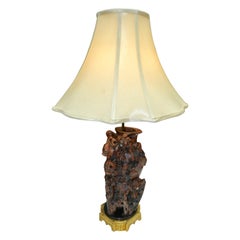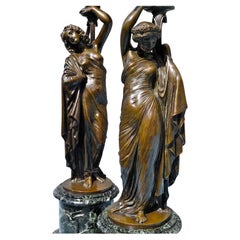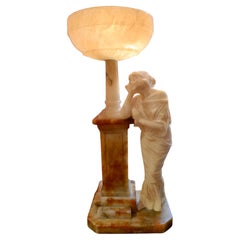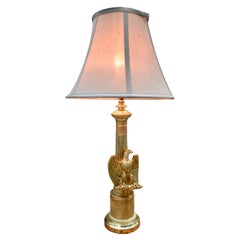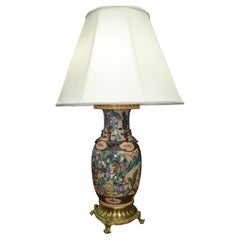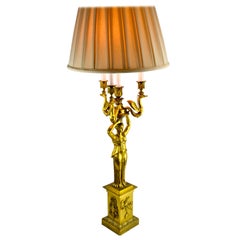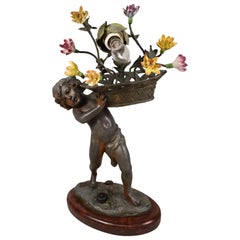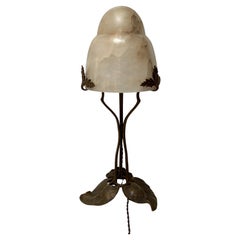Three Centuries Shop Table Lamps
to
9
28
Height
to
Width
to
24
7
6
3
1
1
1
1
1
18
9
6
3
1
1
18
15
12
5
5
19
15
9
5
4
28
28
28
1
1
1
1
Chinese Carved Soapstone Lamp
Located in Vancouver, British Columbia
A carved soapstone lamp base, unusual because of the color of the stone; reddish, brown and black. The carving is in the shape of a vase which i...
Category
Early 20th Century Chinese Chinese Export Table Lamps
Materials
Sandstone
Pair of French 19th Century Figurative Patinated Bronze Candelabra Lamps
By J. Pradier
Located in Vancouver, British Columbia
A beautifully cast pair of French 19th century neoclassical patinated figural bronze nine arm candelabra after a model by Jaen Jacques Pradier They are signed J. Pradier and were converted into lamps in the 20th century. Each candelabra is cast as classically draped maiden with one representing Phyrne and the other unknown, standing on a circular stepped dark green marble socle base. There are no visible foundry marks on the bronzes.
Born in Geneva in 1792 in Switzerland, Pradier was the son of a Protestant family from Toulouse. He left for Paris in 1807 to work with his elder brother, Charles-Simon Pradier, an engraver, and also attended the École des Beaux-Arts beginning in 1808. He won a Prix de Rome that enabled him to study in Rome from 1814-1818 at the Villa Médici. Pradier made his debut at the Salon in 1819 and quickly acquired a reputation as a competent artist. He studied under Jean-Auguste-Dominique Ingres in Paris. In 1827 he became a member of the Académie des beaux-arts and a professor at the École des Beaux-Arts.
At the Salon of 1834, Pradier's Satyr and Bacchante...
Category
Antique Late 19th Century French Neoclassical Table Lamps
Materials
Bronze
Art Nouveau Figural Alabaster Lamp
Located in Vancouver, British Columbia
A figure of a standing young lady finely carved in white alabaster. She is shown dressed in an almost ‘flapper’ style skirt as she leans with her elbows against an ochre mottled rectangular alabaster column on a further stepped base. Her eyes are almost closed as if she is dreaming. The lower rectangular column supports a fluted round column which holds a hollowed white alabaster bowl...
Category
Early 20th Century Italian Art Nouveau Table Lamps
Materials
Alabaster
French Empire style Brass Column Lamp with an Eagle
By Empire Art Products Co.
Located in Vancouver, British Columbia
A highly decorative French empire style lamp likely made in the early 20thC. The polished brass column was likely the stem of a candelabra which was later embellished with an eagle ...
Category
Early 20th Century French Empire Table Lamps
Materials
Brass
$760 Sale Price
20% Off
A 19 Century Nanking Porcelain Vase on an Ormolu base turned into a Lamp
Located in Vancouver, British Columbia
A large late 19 Century Qing Era Chinese Nanking Porcelain Vase in famille verte crackle glaze decorated with intricate warrior and landscape scenes The vase would have been exported to France from Nanking China...
Category
Antique Late 19th Century Asian Chinese Export Table Lamps
Materials
Porcelain
$1,280 Sale Price
20% Off
19th Century Russian Empire Gilt Bronze Figural Candelabra Lamp
Located in Vancouver, British Columbia
A finely cast and gilded Russian Empire style candelabra that was transformed into a lamp; featuring a classical maiden holding aloft three winged sea horses terminating in candle no...
Category
Antique Early 19th Century Russian Empire Table Lamps
Materials
Bronze
Louis XVI Style Gilt Bronze and White Marble Vase Turned into a Lamp
Located in Vancouver, British Columbia
A fine quality Louis XVI style gilt bronze and white marble classically shaped urn now converted to a lamp. The egg shaped white marble body is richly mounted in finely chased gilded...
Category
Antique Late 19th Century French Louis XVI Table Lamps
Materials
Marble, Bronze
Pair of English Early 20 Century Cut Crystal Lamps
Located in Vancouver, British Columbia
A pair of heavily cut crystal lamp bases; the stems cut in various designs; the bottom of the rectangular bases are also heavily cut.
Category
Antique Early 19th Century English Adam Style Table Lamps
Materials
Crystal
$3,600 Sale Price
20% Off
Empire Style Crystal and Gilt Bronze Urn Lamp
Located in Vancouver, British Columbia
A twin handled Empire urn in gilded bronze, the two arms decorated with medusa heads, and classical heads below. Gilt grape leaves encircle the ovoid body. The urn sits on a decorate...
Category
Antique Late 19th Century French Empire Table Lamps
Materials
Crystal, Bronze
19th Century French 'Rope Twist' Baccarat Lamp
By Baccarat
Located in Vancouver, British Columbia
A late 19th century French crystal lamp by the famous Paris Baccarat company in the design referred to as 'rope twist'. There are five crystal components that make up the lamp. The c...
Category
Antique Late 19th Century French Belle Époque Table Lamps
Materials
Crystal
$1,760 Sale Price
20% Off
19th Century Louis XV Style Rococo Gilt Bronze Figural Lamp
Located in Vancouver, British Columbia
A French gilded bronze figural lamp featuring a standing classically draped lady with a cupid in her arms who further holds aloft a cornucopia containing the socket; the whole restin...
Category
Antique Mid-19th Century French Louis XV Table Lamps
Materials
Bronze
Large Louis XVI Style Gilt Bronze Figural Lamp
Located in Vancouver, British Columbia
An unusual French gilt bronze candelabra, now wired as a lamp, combining Louis XVI and late Empire styles. An elegantly draped young lady sits beside her open jewellery box with thre...
Category
Antique Late 19th Century French Louis XVI Table Lamps
Materials
Bronze
French Sevres Bisque Porcelain and Gilt Bronze Candelabra Lamp Signed Feuchere
By Manufacture Nationale de Sèvres
Located in Vancouver, British Columbia
A beautifully cast French Serves bisque porcelain grouping showing two classically draped maidens or Graces standing on a circular bisque base with flutes and inset with decorative flames, on a further bisque base decorated with grapes and palmettes, the whole on a circular gilded bronze base resting on three tupie feet. Between the heads of the maidens there is a decorative gilded shaft which supports the 'new' top electrics as well as three curved gilded candle arms and nozzles. Incised on the top and back of the bisque base is the Sevres stamp with a number 2 between the interlaced L's. There is also the original sculptor's name J. J Feuchere for Jean Jacques Feuchere ( 1805 - 1852) etched on the base under the Graces...
Category
Antique Mid-19th Century French Louis XVI Table Lamps
Materials
Bronze
$4,400 Sale Price
32% Off
Rare Pair of Famille Rose Porcelain and Ormolu Napoleon III Oil Lamps
Located in Vancouver, British Columbia
A beautiful French and Asian collaboration of a 19thC pair of Napoleon III Famille Rose porcelain, (from Canton China), and gilt bronze and brass oil lamps that miraculously include ...
Category
Antique Late 19th Century Chinese Napoleon III Porcelain
Materials
Ormolu
$6,000 Sale Price / set
20% Off
A Pair of French Empire Style Patinated and Gilt Bronze Winged Victory Lamps
Located in Vancouver, British Columbia
A fine pair of late 19thC French Empire style candelabra now wired into lamps. The very well cast and patinated winged Victory or Nike s...
Category
Antique Late 19th Century French Empire Table Lamps
Materials
Marble, Bronze
Silvered Bronze French Empire style Bouillotte Lamp
Located in Vancouver, British Columbia
A fine example of a French Empire bouillotte lamp made of silvered bronze. The circular base supports four decorative candle arms with nozzles; ...
Category
Early 20th Century English Empire Table Lamps
Materials
Bronze
19th Century Cut Crystal Brass Trimmed Baccarat Style Lamp
By Baccarat
Located in Vancouver, British Columbia
A late 19th C cut crystal oil lamp now electrified. Fortunately the wiring is external so there is no damage to the original lamp. The crystal and bra...
Category
Antique Late 19th Century French Louis Philippe Table Lamps
Materials
Crystal, Brass
French Empire Paris Porcelain Vase Converted into a Lamp
Located in Vancouver, British Columbia
A French Empire period porcelain vase. The vase is totally gilt with matte and burnished highlights. The twin handles each show a modeled classical female head and on the front of the vase is a painted classical scene. The scene depicts a Roman/Greek seated young warrior...
Category
Antique Early 18th Century French Empire Table Lamps
Materials
Porcelain
Oil Lamp Featuring a Mathurin Moreau Bronze Statue of a Nymph and Putto
By Mathurin Moreau
Located in Vancouver, British Columbia
A rare bronze statue of na Nymph and a clinging putto by famous French 19 Century sculptor Mathurin Moreau which was custom transformed into an oil lamp. The nymph is is holding al...
Category
Antique Late 19th Century French Napoleon III Figurative Sculptures
Materials
Bronze
Period Art Deco Silvered Bronze Lamps/Candlesticks
By Christofle
Located in Vancouver, British Columbia
Three vertical candle arms rise from a hexagonal base. The lamps/sticks are hallmarked with a heart symbol and the letters O and E on either side of the heart symbol. Other hallmarks...
Category
Vintage 1920s French Art Deco Table Lamps
Materials
Bronze
Pair of French 19 Century Neoclassical Figurative Bronze Lamps
Located in Vancouver, British Columbia
A pair of French restauration period figurative lamps bases featuring patinated bronze classically draped standing figures one representing Diana with her trademark bow and quiver of...
Category
Antique Mid-19th Century French Restauration Table Lamps
Materials
Bronze
Patinated and Gilt Bronze Six Candle French Empire Candelabra Lamp
Located in Vancouver, British Columbia
A patinated and gilt bronze six candle French Empire candelabra that has been converted into a lamp.
Category
Antique Mid-19th Century French Empire Revival Table Lamps
Materials
Bronze
$960 Sale Price
20% Off
Early 20th Century Chinese Carved Green Jadeite Quartz Lamp
Located in Vancouver, British Columbia
A relatively large Chinese carved stone lamp mounted on a stepped brass and a carved wood base. The carved stone is often referred to as Jadeite or Quartz but is in fact from the flu...
Category
Early 20th Century Chinese Chinese Export Table Lamps
Materials
Quartz
Pair of Chinese Export Jadeite Stone Lamps
Located in Vancouver, British Columbia
The stone bodies of this type of interior illuminated lamp are often referred to as quartz, jadeite or even jade but are in fact of the fluorite famil...
Category
Mid-20th Century Asian Chinese Export Table Lamps
Materials
Quartz
$2,000 Sale Price / item
20% Off
Large Carved Jadeite 'flourite' Lamp
Located in Vancouver, British Columbia
The stone bodies of this type of interior illuminated lamp are often referred to as quartz, jadeite or even jade but are in fact of the fluorite family, a softer sone more easily car...
Category
Vintage 1930s Southeast Asian Chinese Export Table Lamps
Materials
Quartz
Pair of 19iCentury Meiji Period Japanese Bronze Censers Turned into Lamps
Located in Vancouver, British Columbia
A pair of baluster form patinated Meiji Period Japanese bronze censers with embossed geometric patterns and flowers all-over and handles of a s...
Category
Antique Late 19th Century Japanese Meiji Table Lamps
Materials
Bronze
Chinese Celadon Vase Lamp with a French 19 Century Gilt Bronze Base
By Henry Dasson
Located in Vancouver, British Columbia
A Chinese celadon baluster vase lamp (likely 20th century porcelain) with loose ring handles on its neck. The vase is now set on a large scale finely chased and gilded bronze 19th ce...
Category
Antique Late 19th Century Chinese Belle Époque Table Lamps
Materials
Bronze
$1,600 Sale Price
54% Off
Carved White Alabaster Lamps Modelled After Roman Temple Ruins
Located in Vancouver, British Columbia
A pair of carved alabaster lamps representing ancient ‘Roman’ architecture; each having three tall fluted columns with Corinthian capitals supporting a stepped top and resting on a r...
Category
Mid-20th Century Italian Classical Roman Table Lamps
Materials
Alabaster
Related Items
French Art Nouveau Figural Lamp with Flower Basket Charles Perror, France
Located in Toledo, OH
Figural Art Nouveau lamp with child holding a basket of colorful flowers. Made in Paris France by Charles Perror 1862-1934. Working order. Dimensions: 13" H x 7" W x 5" D.
Category
Early 20th Century Unknown Art Nouveau Table Lamps
Materials
Metal
Art Nouveau lamp circa 1910
Located in NANTES, FR
Beautiful Art Nouveau lamp, circa 1910.
Brown-veined alabaster shell.
The base is bronze with floral decoration.
Electric and in perfect condition.
Total Height: 52 cm
Shell Diamete...
Category
Vintage 1910s French Art Nouveau Table Lamps
Materials
Alabaster, Bronze
Hand Carved Wooden Sculpture Lamp Night Watchman with Lantern, Germany
Located in Barntrup, DE
A masterfully hand-carved wooden lamp features a beautiful sculpture of a night watchman with a lantern and halberd. The lantern is made of glass and co...
Category
Mid-20th Century German Black Forest Table Lamps
Materials
Copper
$869
H 19.49 in W 7.49 in D 4.73 in
Italian Marble and Alabaster Figural Table Lamp
Located in Montreal, QC
Marble and alabaster figure of Ruth (14" high), resting beside column while gleaning grain; her flesh of carrara marble, her dress of pink stained alabaster, offered with a box-pleat...
Category
Early 20th Century Italian Table Lamps
Materials
Alabaster, Marble
Art Deco Alabaster Figural Lamp
Located in Cheshire, GB
Art Deco alabaster figural lamp modelled as an Egyptian Revival dancing girl having arms raised below the bowl-shaped shade. The lamp has been r...
Category
Early 20th Century British Table Lamps
Materials
Alabaster
French Empire Gilded Bronze Bouillotte Lamp with 3 Eagle Arms
By Maison Lucien Gau
Located in Halle, DE
A beautiful 20th Century classic French Empire gilded Bronze Bouillotte Lamp with 3 sculptural Eagle Arms .
The Bouillotte Lamp present a classic dark-green painted tole shade with ...
Category
Vintage 1960s French Empire Table Lamps
Materials
Brass, Bronze
Majorelle Art Nouveau Lamp
By Atelier Majorelle
Located in NANTES, FR
Majorelle Art Nouveau lamp
Large lamp around 1900 foot in gilded bronze and lampshade in alabaster.
Very good quality of bronze and pretty floral m...
Category
Early 20th Century French Art Nouveau Table Lamps
Materials
Alabaster, Bronze
Amazing Pair of French 19th Century Bronze and Gilt Bronze Candelabras
Located in Rome, IT
A fine pair of French 19th century bronze and gilt bronze candelabras, each with a dark bronze delicious dancing putto figures and parrots holding aloft three scrolled candle-branche...
Category
Antique 19th Century French Louis XVI Candle Holders
Materials
Bronze
$19,200 Sale Price
20% Off
H 28.35 in Dm 13.78 in
19th Century Rose Ormolu Mounted Rose Medallion Vase / Lamp
Located in Brighton, Sussex
A very good quality 19th century Chinese rose medallion Cantonese vase / lamp, having wonderful gilded ormolu mounts to the top and base. Hand painted classical oriental scenes, depi...
Category
Antique 19th Century Chinese Chinese Export Table Lamps
Materials
Porcelain
Art Nouveau Desk Lamp
Located in NANTES, FR
Desk lamp in gilded spelter circa 1910. Tulip tilt adjustment possible.
Tulip in opalescent glass.
Electrified, B22 socket.
in perfect condition.
Height: 34 cm
Width: 25 cm
Depth: 1...
Category
Early 20th Century French Art Nouveau Table Lamps
Materials
Spelter
Fine French Empire 19th Century Bronze Candelabras Mounted as Lamps, Pair
Located in Miami, FL
Fine French Empire 19th Century Bronze Candelabras Mounted as Lamps, Pair
A pair of fine French 19th century Empire bronze candelabras that have been electrified and converted to ta...
Category
Antique 19th Century French Empire Table Lamps
Materials
Marble, Bronze
$3,750 Sale Price / set
53% Off
H 35.5 in W 14 in D 14 in
19th Century Empire Gilt Bronze Bouillotte Table Lamp
Located in LA CIOTAT, FR
A very stylish 19th century Empire style 'Bouillotte' table lamp in gilt bronze, lit by three curvaceous 'swans head' arms and topped with a green lacquered metal (tole) shade adorne...
Category
Antique 19th Century French Empire Table Lamps
Materials
Bronze
